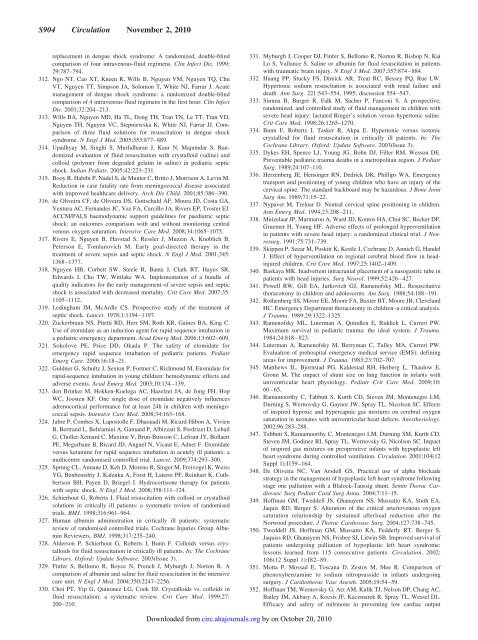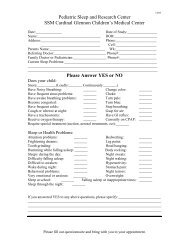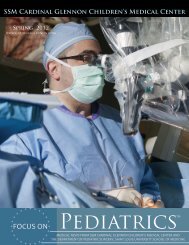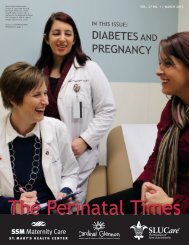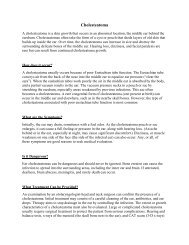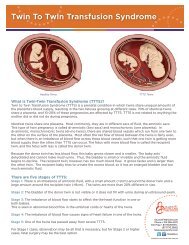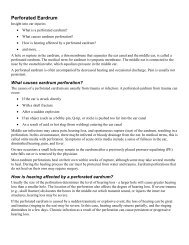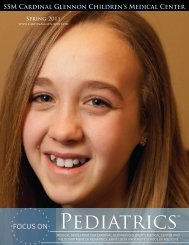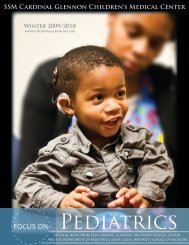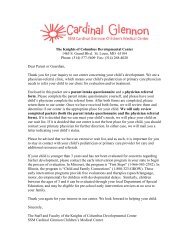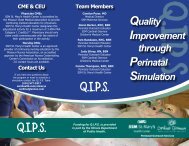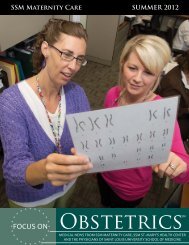pediatric-ALS-AHA-guidelines-circulation_11-2010 - SSM Cardinal ...
pediatric-ALS-AHA-guidelines-circulation_11-2010 - SSM Cardinal ...
pediatric-ALS-AHA-guidelines-circulation_11-2010 - SSM Cardinal ...
Create successful ePaper yourself
Turn your PDF publications into a flip-book with our unique Google optimized e-Paper software.
S904 Circulation November 2, <strong>2010</strong>replacement in dengue shock syndrome: A randomized, double-blindcomparison of four intravenous-fluid regimens. Clin Infect Dis. 1999;29:787–794.312. Ngo NT, Cao XT, Kneen R, Wills B, Nguyen VM, Nguyen TQ, ChuVT, Nguyen TT, Simpson JA, Solomon T, White NJ, Farrar J. Acutemanagement of dengue shock syndrome: a randomized double-blindcomparison of 4 intravenous fluid regimens in the first hour. Clin InfectDis. 2001;32:204–213.313. Wills BA, Nguyen MD, Ha TL, Dong TH, Tran TN, Le TT, Tran VD,Nguyen TH, Nguyen VC, Stepniewska K, White NJ, Farrar JJ. Comparisonof three fluid solutions for resuscitation in dengue shocksyndrome. N Engl J Med. 2005;353:877–889.314. Upadhyay M, Singhi S, Murlidharan J, Kaur N, Majumdar S. Randomizedevaluation of fluid resuscitation with crystalloid (saline) andcolloid (polymer from degraded gelatin in saline) in <strong>pediatric</strong> septicshock. Indian Pediatr. 2005;42:223–231.315. Booy R, Habibi P, Nadel S, de Munter C, Britto J, Morrison A, Levin M.Reduction in case fatality rate from meningococcal disease associatedwith improved healthcare delivery. Arch Dis Child. 2001;85:386–390.316. de Oliveira CF, de Oliveira DS, Gottschald AF, Moura JD, Costa GA,Ventura AC, Fernandes JC, Vaz FA, Carcillo JA, Rivers EP, Troster EJ.ACCM/P<strong>ALS</strong> haemodynamic support <strong>guidelines</strong> for paediatric septicshock: an outcomes comparison with and without monitoring centralvenous oxygen saturation. Intensive Care Med. 2008;34:1065–1075.317. Rivers E, Nguyen B, Havstad S, Ressler J, Muzzin A, Knoblich B,Peterson E, Tomlanovich M. Early goal-directed therapy in thetreatment of severe sepsis and septic shock. N Engl J Med. 2001;345:1368–1377.318. Nguyen HB, Corbett SW, Steele R, Banta J, Clark RT, Hayes SR,Edwards J, Cho TW, Wittlake WA. Implementation of a bundle ofquality indicators for the early management of severe sepsis and septicshock is associated with decreased mortality. Crit Care Med. 2007;35:<strong>11</strong>05–<strong>11</strong>12.319. Ledingham IM, McArdle CS. Prospective study of the treatment ofseptic shock. Lancet. 1978;1:<strong>11</strong>94–<strong>11</strong>97.320. Zuckerbraun NS, Pitetti RD, Herr SM, Roth KR, Gaines BA, King C.Use of etomidate as an induction agent for rapid sequence intubation ina <strong>pediatric</strong> emergency department. Acad Emerg Med. 2006;13:602–609.321. Sokolove PE, Price DD, Okada P. The safety of etomidate foremergency rapid sequence intubation of <strong>pediatric</strong> patients. PediatrEmerg Care. 2000;16:18–21.322. Guldner G, Schultz J, Sexton P, Fortner C, Richmond M. Etomidate forrapid-sequence intubation in young children: hemodynamic effects andadverse events. Acad Emerg Med. 2003;10:134–139.323. den Brinker M, Hokken-Koelega AC, Hazelzet JA, de Jong FH, HopWC, Joosten KF. One single dose of etomidate negatively influencesadrenocortical performance for at least 24h in children with meningococcalsepsis. Intensive Care Med. 2008;34:163–168.324. Jabre P, Combes X, Lapostolle F, Dhaouadi M, Ricard-Hibon A, VivienB, Bertrand L, Beltramini A, Gamand P, Albizzati S, Perdrizet D, LebailG, Chollet-Xemard C, Maxime V, Brun-Buisson C, Lefrant JY, BollaertPE, Megarbane B, Ricard JD, Anguel N, Vicaut E, Adnet F. Etomidateversus ketamine for rapid sequence intubation in acutely ill patients: amulticentre randomised controlled trial. Lancet. 2009;374:293–300.325. Sprung CL, Annane D, Keh D, Moreno R, Singer M, Freivogel K, WeissYG, Benbenishty J, Kalenka A, Forst H, Laterre PF, Reinhart K, CuthbertsonBH, Payen D, Briegel J. Hydrocortisone therapy for patientswith septic shock. N Engl J Med. 2008;358:<strong>11</strong>1–124.326. Schierhout G, Roberts I. Fluid resuscitation with colloid or crystalloidsolutions in critically ill patients: a systematic review of randomisedtrials. BMJ. 1998;316:961–964.327. Human albumin administration in critically ill patients: systematicreview of randomised controlled trials. Cochrane Injuries Group AlbuminReviewers. BMJ. 1998;317:235–240.328. Alderson P, Schierhout G, Roberts I, Bunn F. Colloids versus crystalloidsfor fluid resuscitation in critically ill patients. In: The CochraneLibrary. Oxford: Update Software. 2003(Issue 3).329. Finfer S, Bellomo R, Boyce N, French J, Myburgh J, Norton R. Acomparison of albumin and saline for fluid resuscitation in the intensivecare unit. N Engl J Med. 2004;350:2247–2256.330. Choi PT, Yip G, Quinonez LG, Cook DJ. Crystalloids vs. colloids influid resuscitation: a systematic review. Crit Care Med. 1999;27:200–210.331. Myburgh J, Cooper DJ, Finfer S, Bellomo R, Norton R, Bishop N, KaiLo S, Vallance S. Saline or albumin for fluid resuscitation in patientswith traumatic brain injury. N Engl J Med. 2007;357:874–884.332. Huang PP, Stucky FS, Dimick AR, Treat RC, Bessey PQ, Rue LW.Hypertonic sodium resuscitation is associated with renal failure anddeath. Ann Surg. 221:543–554, 1995; discussion 554–547.333. Simma B, Burger R, Falk M, Sacher P, Fanconi S. A prospective,randomized, and controlled study of fluid management in children withsevere head injury: lactated Ringer’s solution versus hypertonic saline.Crit Care Med. 1998;26:1265–1270.334. Bunn F, Roberts I, Tasker R, Akpa E. Hypertonic versus isotoniccrystalloid for fluid resuscitation in critically ill patients. In: TheCochrane Library. Oxford: Update Software. 2003(Issue 3).335. Dykes EH, Spence LJ, Young JG, Bohn DJ, Filler RM, Wesson DE.Preventable <strong>pediatric</strong> trauma deaths in a metropolitan region. J PediatrSurg. 1989;24:107–<strong>11</strong>0.336. Herzenberg JE, Hensinger RN, Dedrick DK, Phillips WA. Emergencytransport and positioning of young children who have an injury of thecervical spine. The standard backboard may be hazardous. J Bone JointSurg Am. 1989;71:15–22.337. Nypaver M, Treloar D. Neutral cervical spine positioning in children.Ann Emerg Med. 1994;23:208–2<strong>11</strong>.338. Muizelaar JP, Marmarou A, Ward JD, Kontos HA, Choi SC, Becker DP,Gruemer H, Young HF. Adverse effects of prolonged hyperventilationin patients with severe head injury: a randomized clinical trial. J Neurosurg.1991;75:731–739.339. Skippen P, Seear M, Poskitt K, Kestle J, Cochrane D, Annich G, HandelJ. Effect of hyperventilation on regional cerebral blood flow in headinjuredchildren. Crit Care Med. 1997;25:1402–1409.340. Baskaya MK. Inadvertent intracranial placement of a nasogastric tube inpatients with head injuries. Surg Neurol. 1999;52:426–427.341. Powell RW, Gill EA, Jurkovich GJ, Ramenofsky ML. Resuscitativethoracotomy in children and adolescents. Am Surg. 1988;54:188–191.342. Rothenberg SS, Moore EE, Moore FA, Baxter BT, Moore JB, ClevelandHC. Emergency Department thoracotomy in children–a critical analysis.J Trauma. 1989;29:1322–1325.343. Ramenofsky ML, Luterman A, Quindlen E, Riddick L, Curreri PW.Maximum survival in <strong>pediatric</strong> trauma: the ideal system. J Trauma.1984;24:818–823.344. Luterman A, Ramenofsky M, Berryman C, Talley MA, Curreri PW.Evaluation of prehospital emergency medical service (EMS): definingareas for improvement. J Trauma. 1983;23:702–707.345. Matthews IL, Bjornstad PG, Kaldestad RH, Heiberg L, Thaulow E,Gronn M. The impact of shunt size on lung function in infants withuniventricular heart physiology. Pediatr Crit Care Med. 2009;10:60–65.346. Ramamoorthy C, Tabbutt S, Kurth CD, Steven JM, Montenegro LM,Durning S, Wernovsky G, Gaynor JW, Spray TL, Nicolson SC. Effectsof inspired hypoxic and hypercapnic gas mixtures on cerebral oxygensaturation in neonates with univentricular heart defects. Anesthesiology.2002;96:283–288.347. Tabbutt S, Ramamoorthy C, Montenegro LM, Durning SM, Kurth CD,Steven JM, Godinez RI, Spray TL, Wernovsky G, Nicolson SC. Impactof inspired gas mixtures on preoperative infants with hypoplastic leftheart syndrome during controlled ventilation. Circulation. 2001;104(12Suppl 1):I159–164.348. De Oliveira NC, Van Arsdell GS. Practical use of alpha blockadestrategy in the management of hypoplastic left heart syndrome followingstage one palliation with a Blalock-Taussig shunt. Semin Thorac CardiovascSurg Pediatr Card Surg Annu. 2004;7:<strong>11</strong>–15.349. Hoffman GM, Tweddell JS, Ghanayem NS, Mussatto KA, Stuth EA,Jaquis RD, Berger S. Alteration of the critical arteriovenous oxygensaturation relationship by sustained afterload reduction after theNorwood procedure. J Thorac Cardiovasc Surg. 2004;127:738–745.350. Tweddell JS, Hoffman GM, Mussatto KA, Fedderly RT, Berger S,Jaquiss RD, Ghanayem NS, Frisbee SJ, Litwin SB. Improved survival ofpatients undergoing palliation of hypoplastic left heart syndrome:lessons learned from <strong>11</strong>5 consecutive patients. Circulation. 2002;106(12 Suppl 1):I82–89.351. Motta P, Mossad E, Toscana D, Zestos M, Mee R. Comparison ofphenoxybenzamine to sodium nitroprusside in infants undergoingsurgery. J Cardiothorac Vasc Anesth. 2005;19:54–59.352. Hoffman TM, Wernovsky G, Atz AM, Kulik TJ, Nelson DP, Chang AC,Bailey JM, Akbary A, Kocsis JF, Kaczmarek R, Spray TL, Wessel DL.Efficacy and safety of milrinone in preventing low cardiac outputDownloaded from circ.ahajournals.org by on October 20, <strong>2010</strong>


